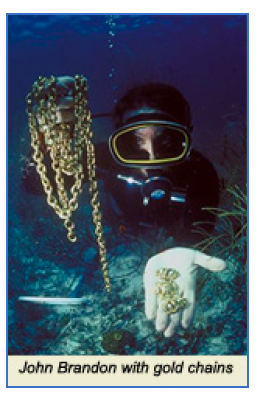Gold Chains of the 1622 Fleet

Gold Chains of the 1622 Fleet
By James Sinclair
Perhaps one of the most unanticipated finds from the 1622 Fleet shipwrecks is the gold chains. This was a class of item that while expected turned up in numbers that were truly staggering. The first of the gold chains to be found came from the area where the first galleon anchor was found in the area of the Quicksands that was dubbed the Bank of Spain.

The first of the chains to be found was a small example but it none-the-less brought much excitement. Brought to the surface by photographer Don Kincaid, it was a thrilling moment for those involved. While some silver coins had been found, along with the galleon anchor, the presence of gold made the find that much more real and exciting.
It was over the course of years, but many chains would be found, literally thousands of feet in total of many different sizes and designs. As one of the members of the team researching and explaining the collection from the wreck, the sheer volume of this class of gold artifact was puzzling.
However more research by historian Dr. Eugene Lyon among others helped to shed light on just why we were seeing so many gold chains being recovered from these important shipwrecks.

Gold chains began to become extremely popular across Europe in the century before the Atocha and Margarita were lost. This fact can be seen in the many portraits dating from that time that show the wealthy (both men and women) wearing chains of gold. Women would wear the chains as, necklace, belt or choker. Men would wear them either around the neck or over the shoulder with and without suspended decorations.
In fact, in Spain several edicts were passed by King Philip II court that prohibited the ostentatious jewelry that was in vogue during the reign of his father Charles V. This earlier jewelry can be seen in many paintings of that earlier period. Perhaps one of the best known is the portrait of Henry VIII wearing his famous collar of gold and jewel
encrusted pendants. Indeed, Phillip II became increasingly sensitive to the poverty of the Spanish people, especially after the failed invasion of England in 1588.

In a series of edicts, the wearing of this type of jewelry was forbidden, however the King conceded that the wearing of gold chains was okay. As a result, gold chains of prodigious size and weight began to be manufactured (the bigger the more well off) and their presence in the art of the day begins to show in increasing amounts. By the time of the loss of the Atocha and the Santa Margarita in 1622 the style was firmly implanted in the culture of Spain and by extension it’s colonies in the New World.
However, there were other dimensions to the chains from the 1622 fleet. One of the interesting findings was that some of the largest chains had links of very pure gold (usually 23K) and each of those links weighed a very specific amount. In fact, these links weighed the same as some of the gold coinage that was circulating at the time. Why would this be? Even by the year 1622 the king had not given permission to mint gold coins in the New World, although many had petitioned the court for this to be done. As a consequence, there was a shortage of gold coins in the New World to be used in commerce. So, these chains are thought to represent a way around this shortage and were in a very real sense portable wealth.

There was also a lesser tax on jewelry than on bullion so that even the cost of making of these chains represented a substantial savings over the creation of bullion pieces and the payment of the Quinto (the royal tax of 20%). Once we had realized that this was a sort of end run around the taxes of the time as well as a stand in for gold coinage, the chains that had links that represented the weight of coins were dubbed “money chains”.
The Wedding Chain
(see re-creation wedding chains)
One chain that was recovered from the Santa Margarita merited its own name. Two 3-foot loops of massive gold chain joined by a central link bring this object to nearly 7lbs of gold. Spanish Colonies, as in the Spanish homeland, old customs survived and were adopted into the New World colonies. One of these was the dowry, a payment of the bride’s family to that of the groom’s for the marriage of the daughter to the son. A custom also existed to show the unity of
the two families by placing a “garland” of flowers over the head of the bride and the groom. These flowers were joined by a central loop thus the “unity”. This massive chain seems to echo this custom on both counts hence the name “wedding chain”.


See an authentic Atocha gold money chain for sale
